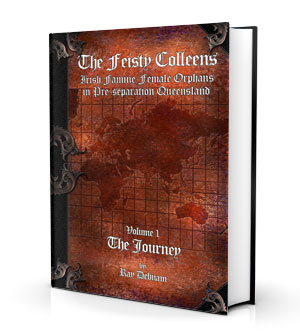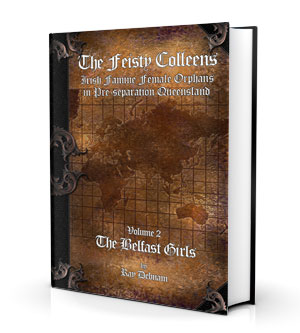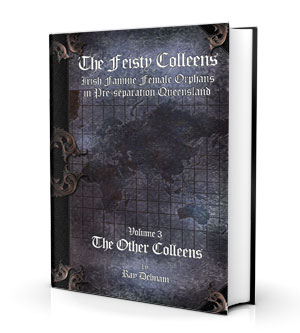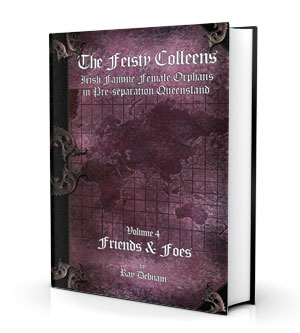An essential resource for any family historian researching the Irish Famine Female Orphans
The much acclaimed ‘Feisty Colleens’ series of e-books concerning the Irish Famine female orphans sent to Australia in general and Queensland in particular between 1848 and 1852 has been extensively revised, with new information being included in all three current volumes. A fourth volume, Friends and Foes, is in preparation and will provide a biographical compendium of known associates of the ‘Feisty Colleens’ in Queensland.
Introduction
Devised by the then British Secretary of State for the Colonies, the Earl Grey, the scheme to transport young Irish famine females who had been made orphans or destitute by the Great Famine was intended to solve a variety of problems - to alleviate the stress on the workhouses in Ireland, and thus reduce the cost to the British Government in supporting the Irish poor, and to partially rectify the gender imbalance while also providing a supply of much needed unskilled labour for the growing colonies. But there were opponents as well as supporters for the Irish famine female orphan emigration scheme and, being the first shipload to be sent to the colony of New South Wales under that scheme, the orphan girls from the ship Earl Grey were subjected to very close scrutiny.
Unfortunately for the girls, but fortunate for the opponents of the scheme, during the 124 day voyage out to Sydney factions and squabbles developed between some girls from different counties, much to the chagrin of the ship's surgeon superintendent, Dr Henry Grattan Douglass. Immediately on arriving in Sydney Cove, Dr Douglass made a strong complaint to the Sydney Orphan Committee which resulted in the establishment of an urgent Board of Enquiry into the behaviour of the young women during the voyage and their selection process. In the meantime, all 183 Irish famine female orphans were confined to the ship, still anchored in the harbour.
With his harshest criticism levelled at the girls sent from the Belfast Workhouse, Dr Douglass insisted these fractious women should not be allowed to land in Sydney but be transferred immediately to more remote parts of the colony. The Board of Enquiry agreed with him and forty nine orphans, now dubbed the 'Belfast girls', were identified to be sent to either Maitland (twelve) or Moreton Bay (thirty seven). Although not identified as a 'Belfast girl', another orphan, Mary Jane Gray, was indentured for two years to a Mr J. Smith of Moreton Bay and appears to have been sent there with the others. Accordingly, for ease of reference, she has been included as a 'Belfast girl'.
Refugees from one of the worst famines in modern European history, these young women were now destined to become pioneers in their new country. Sent to remote locations with little or no civil infrastructure or established facilities, they played a crucial role in the opening up and development of the outlying areas of the colony of New South Wales.
This was particularly so with the settlement of Moreton Bay. Opened to free settlers just six years before, the town of Brisbane had developed little from its days as a convict outpost when the first group of Irish famine female orphans arrived on 21 October, 1848.
Initially intended to provide domestic service to the fledgling town, the young women soon married and had families of their own. Within a few years they had spread to the wider areas of settlement, and even beyond. Many engaged in business, often encouraging others to leave Ireland and join them in the new land of opportunity, and some even provided employment for those who came behind.
But they were not always treated kindly by their employers, or society, and were often subjected to the same racial and religious prejudices and class arrogance which had prevailed in far-off Ireland and Britain. However, having beaten the worst the famine and disease could throw at them, including the death of loved ones and the rigours of the Workhouse, they were survivors, with an inner strength and resilience not normally found in ones so young. Being survivors they were also fighters, and frequently rebelled against those who sought to contain them.
Much to the dismay of many an employer, these feisty young women often sought out the company of another set of outcasts, the ex-convicts and bullock drivers, for there was always music, laughter, and acceptance in the bullocky camps. So much so that quite a few of the orphans married bullockies and/or transportees.
Probably in a bid to escape the confinement of their servitude, many married young, perhaps too young, with one girl, Sarah Browne, then aged 17, marrying just over two months after her arrival in Brisbane. But not all made wise choices when selecting their future life-partner and some sought respite from their misery in the all-too-available 'grog', diluted rum.
Despite the hardships, most of the Irish famine female orphans took to their new country with a will, becoming integral to the growth of the Moreton Bay settlement and its subsequent development into the separate colony of Queensland. In all, from the eleven orphan ships sent to New South Wales, a possible total of 229 Irish orphans have been identified with Moreton Bay - 195 by name as having been sent or known to have been in Moreton Bay, thirteen by name believed to have been sent, and a further twenty one who may have been sent, along with seven known to have travelled there with their husbands.
The intent of the series is not to be the culmination of a researcher's quest into these remarkable women, but a guide for the beginning.
Each Book Examined
The JourneyBefore they could start their new life in the once penal outpost of Moreton Bay in the colony of New South Wales, the Irish Famine female orphans had to make several voyages - first across the Irish Sea on a paddle steamer, then through tropical and sub-Antarctic climes as they sailed to Sydney, Melbourne or Adelaide and finally up the east coast of Australia to the fledgling settlement of Brisbane. The Journey provides an insight into all three voyages as well as details on the ships themselves. Research subjects to be found within The Journey include:
|
The Belfast GirlsFollowing on from the journey the orphans made in their escaping the horrors of the Great Famine, the Belfast Girls is designed to aid the family historian and researcher in studying the lives of the first group of Irish orphans to be sent to Moreton Bay. Within these pages you will find:
The Belfast Girls is a must-have for any researcher interested in the Irish Famine female orphans in pre-separation Queensland. |
The Other ColleensWithin a few months of the arrival of the 'Belfast girls' in Moreton Bay in October 1848 another 50 orphans were landed at South Brisbane from the paddle steamer Eagle. They were the first of some 220 female orphans to be sent to the once penal outpost during the period 1849-1852. The Other Colleens provides a detailed study on the lives and times of those orphans who came after the 'Belfast girls'. Research subjects to be found in The Other Colleens include:
A companion to The Journey and The Belfast Girls, The Other Colleens is an essential research aid for those interested in the Irish Famine female orphans in pre-separation Queensland. |
|||
Coming Soon
| |||||
Author's comments
The inspiration for the ‘Feisty Colleens’ series was my g-g-grandmother, one of the original Earl Grey famine orphans and a ‘Belfast Girl’. In the beginning all I knew about her was that she married my g-g-grandfather in Moreton Bay in 1849 and I wanted to know more. Very soon after I started to research her life I discovered she was a ‘Belfast Girl’ and then realised that to know her I needed to address the other 37 orphans who went to Brisbane with her. However, the more information I found the more I identified information I needed to find. As a consequence, my research identified 220 Irish Famine female orphans associated with Moreton Bay, and so began the ‘Feisty Colleens’ series. The current three volumes are the result of more than ten years’ intense research, research which involved spending hundreds of hours in the Queensland State Library scanning innumerable reels of microfilm and microfiche records, in addition to searching through countless websites on my personal computer at home and trawling through many hardcopy publications, always looking for that extra gem of information which would complete, or at least contribute to filling the gaps in another orphan’s life. I sought help from several professional historians and researchers, including Jennifer Harrison and two other well-known authorities on the Irish orphans, Trevor McClaughlin and Libby Connors, all of whom graciously provided invaluable support and guidance, particularly Jenny, for which I am eternally grateful.







